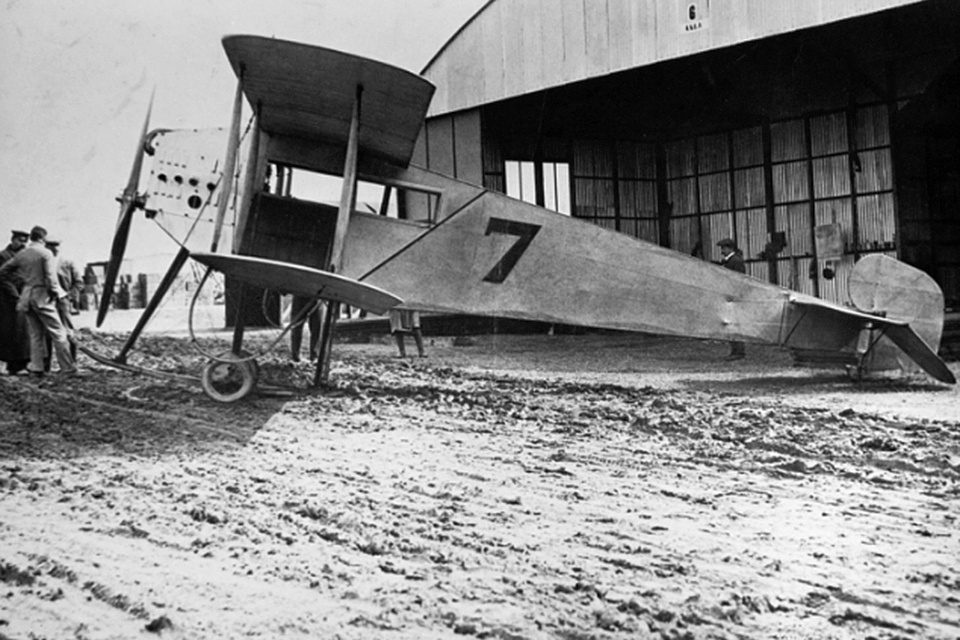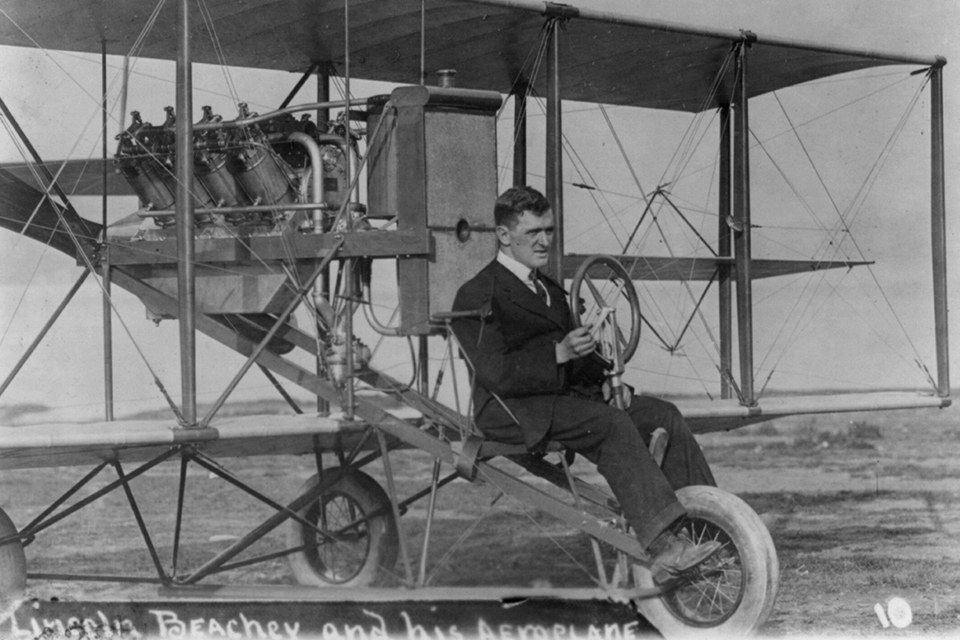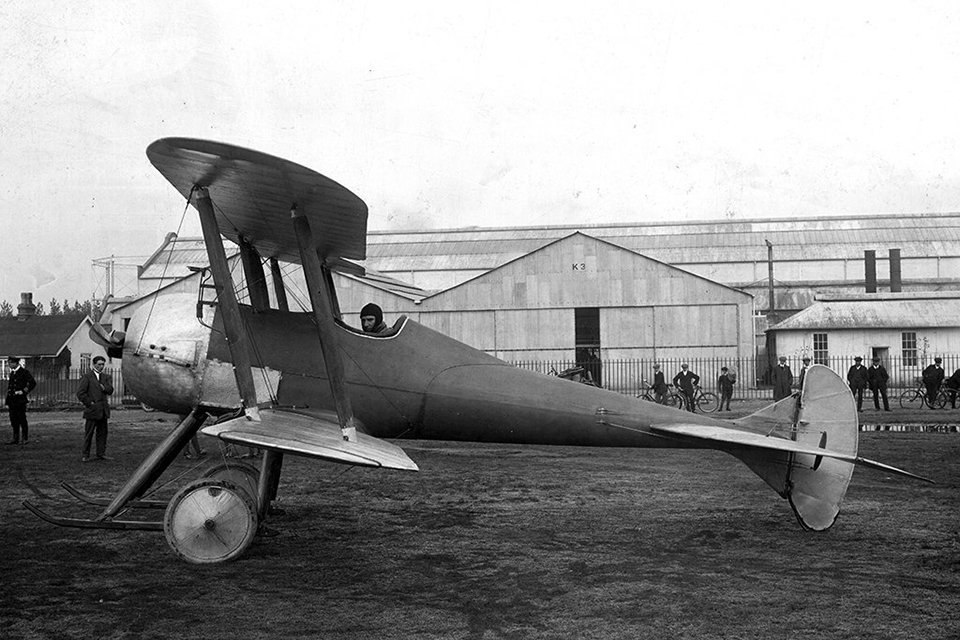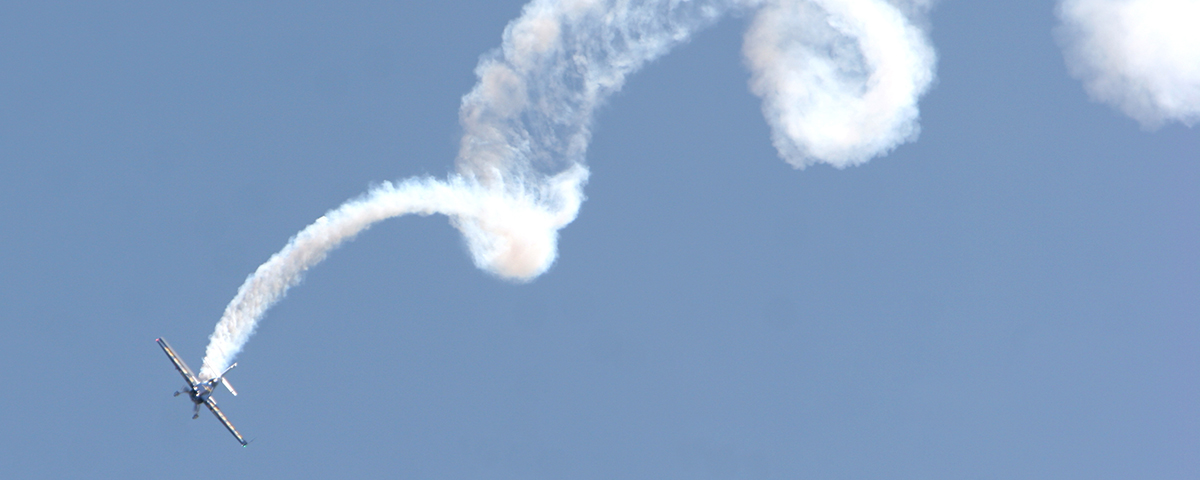A century ago, the spin was a deeply mysterious and deadly phenomenon that struck without warning and had no known cure.
The skies above Stonehenge were bright and breezy on the morning of August 25, 1912. Some 600 feet over Salisbury Plain, Lieutenant Wilfred Parke had nearly completed a three-hour endurance test in a primitive wood and wire-braced biplane. The flight was part of Britain’s first military aviation trials, held by the newly formed Royal Flying Corps at Larkhill’s grass airfield.
At the top of Parke’s joystick was a control wheel that warped the wings of his Avro G, one of the first aircraft with an enclosed cabin. Since Parke could barely see the ground—the cabin blocked all forward visibility, requiring him to peer out through the side windows—he decided on an unusual approach. He throttled back and began a spiral glide, intending to land downwind in front of Larkhill’s hangars. Turning too steeply, he tried to compensate by pulling back on the stick and adjusting the warp. Suddenly one wing stalled, and Parke was flung into a dizzying corkscrew, the most dreaded predicament faced by pilots of that era: a spin.
A century ago, the spin was a deeply mysterious and deadly phenomenon that struck without warning and had no known cure. British pilots called it a “spiral dive,” not a spin; after that August morning, they would know it by another name: “Parke’s Dive.”
As a handful of spectators at Larkhill watched in horror, the Avro spiraled steeply toward the ground. Then, at barely 50 feet, Parke miraculously pulled out of the spin and landed safely, leaving some to wonder if the whole incident had been a clever stunt. Among the witnesses was A.E. Berriman, editor of Flight magazine, who three days later wrote up the story of Parke’s Dive in a lengthy article. It included a detailed description of how Parke had managed to recover, related to Berriman immediately after he landed, relieved but shaken. (In Parke’s logbook, he concluded his entry for August 25 with “ghastly experience.”)

The Flight article helped turn the incident into an aviation milestone: the first well-documented case of a pilot successfully correcting and surviving a spin. But the lessons of Parke’s close call would take time to sink in. Over the next few years, deadly spins and stalls claimed countless victims in the mostly underpowered and unstable airplanes of the period, but a fortunate handful of fliers remembered reading about Parke’s Dive and the corrective actions that had saved him, and survived. During World War I, plucky test pilots at Farnborough carried out the first scientific investigations of spins, and the fog of ignorance began to lift. Finally, around 1917, trainee fighter pilots began to be taught spin recovery as part of combat maneuvers.
A story full of heroism and narrow scrapes, the saga of the spin tells us how little was known about the fundamentals of flying and the extraordinary fortitude required by the pioneers of a century ago. But how, exactly, did Parke pull himself back from the brink on that fateful day in August 1912?
Parke, a 22-year-old naval lieutenant and son of a country vicar, had “fair hair that flopped over his forehead in a big forelock, and a face like a polished red apple,” according to one account. He probably owed his survival as much to luck as to exceptional flying skills. He’d managed to scrape together the funds to enroll in the flying school founded by Alliott Verdon Roe, the first Briton to fly, at the famous Brooklands racecourse. There, the day after his first flight in April 1911, Parke stalled and crashed into the neighboring sewage farm, a rite of passage for many novices. His Royal Navy superiors frowned on Parke’s aerial pursuits as frivolous, but after the formation of the Royal Flying Corps in May 1912, complete with a naval wing, the brass changed their tune.
Parke’s cheerful personality made him popular, and he became known for his disarming frankness about the shortcomings of the prototypes he tested. The Avro G, for instance, was a peculiar blend of far-sighted and eccentric design. Its enclosed cabin—highly unusual for the period—promised comfort, but at only 27 inches wide it was a pretty tight squeeze.
During his August 25 flight, Parke was packed into the small cockpit with his legs up, like a rower in a racing scull, since he had a passenger, a Lieutenant Le Breton, sitting in front of him. He reportedly approached his landing at Larkhill confidently (“becoming frisky,” according to one witness). Since the Avro G was nose heavy, when Parke was thrown into a left-hand spin, his first reaction was to slam the throttle wide open, then pull back hard on the stick and warp the wings in the direction of the spin. This was the prescribed method for recovering from a side-slip, but it was exactly the wrong reaction for a spin, since it served to tighten the noose of the spiral.
Parke survived only because, seconds from disaster, he threw intuition to the wind. As centrifugal force tossed the unbelted Le Breton around in front of him, Parke grasped a fuselage strut to steady himself, and this seems to have given him the desperate idea of trying full opposite rudder to the right, against the direction of the spin. The ease with which he had pulled out caused an immediate sensation when he landed. Parke sat down in the competitors’ mess with Berriman and two leading pilots, Geoffrey de Havilland and Frank Short, and together they formulated a basic remedy for spin recovery, distinguishing it from the problem of the side-slip. They recognized that full opposite rudder had checked the centrifugal motion of the tail while speeding up the inside wing, adding lift and enabling the machine to straighten out. It was the world’s first successful recovery and analysis of a spin. Or was it?
Remarkably, the Wright brothers had foreshadowed Parke’s solution a decade earlier, even though their flights over the dunes at Kitty Hawk were so low that they never experienced a full-blown spin. On September 20, 1902, while Wilbur was piloting their second glider, the wind caught its left wing and threatened to tip it over to the right. While trying to warp the wings in the opposite direction, Wilbur accidentally pulled back on the elevator; the glider lost speed and the right wing stalled, sending the aircraft into a curving, slamming impact with the sand. Fortunately he escaped unscathed. Three days later Orville had a similar escapade, accidentally losing speed while trying to correct a turn. “The result,” he wrote, “was a heap of flying machine, cloth, and sticks in a heap, with me in the center without a bruise or a scratch.” Those accidents were still troubling Orville a few nights later as he lay sleepless on his bunk in their wooden cabin beside the dunes, when he suddenly had one of many flashes of genius: the idea of a steerable vertical rudder that could counteract the tendency of the plane to spiral out of control. So by experiencing the first stages of a spin, the Wrights figured out one of many crucial steps in their mastery of flight.
Did any pilot manage to evade a lethal spin before Parke’s Dive? Perhaps the likeliest candidate is Lincoln Beachey, who became America’s highest paid daredevil aviator in the years leading up to World War I. In the summer of 1911, barely six months after learning to fly, Beachey made his first splash. Clad in a dapper business suit, he flew his Curtiss D pusher under the Honeymoon Bridge at Niagara Falls. He followed up that feat by setting a world altitude record of 11,578 feet at the Chicago International Aviation Meet. That same summer he developed a repertoire of colorfully named stunts that electrified crowds: the “Turkey Trot,” “Ocean Roll,” “Dip of Death,” “Corkscrew Flop” and so on. It’s unclear whether any of those maneuvers, notably his “Spiral Glide,” involved a deliberate spin. Even today, accounts of Beachey’s meteoric career are steeped in error and myth, while contemporary newspaper reports of his exhibition flights are frustratingly short on detail. But Carroll Gray, a historian who has thoroughly investigated the record, believes that by 1912 Beachey “was, almost certainly, the first aviator to recover from a spin, do the falling leaf, a hammerhead stall, fly inverted, and do an outside loop as well as most other now standard aerobatic maneuvers.”

The claims of other possible early spinners are more doubtful. French aviator Adolphe Pégoud, who stunned Europe by looping his Blériot monoplane, wrote that he first flew upside down in 1913 after coming out of a “corkscrew” dive. Similar corkscrews were apparently routine for Gustav Hamel in Britain and Alfred Friedrich in Germany, among others, but the evidence suggests these were all fully controlled spiral dives, not spins in an out-of-control, stalled airplane. “Before World War I,” wrote Frank T. Courtney, a test pilot at the Royal Aircraft Factory at Farnborough, “aerobatics were relatively elementary, consisting mainly of loops, steep climbing turns…and vertical banks; but all these were performed within the bounds of a cardinal rule: never lose flying speed. Sometimes, as on the top of a loop, a pilot could legitimately lose flying speed, but only because he counted on regaining it in the ensuing dive. But normally one avoided stalling an airplane as one avoids steering a car into a telegraph pole.”
Meanwhile, true spins continued to claim lives and injure the pilots who survived them. At Farnborough in March 1913, Geoffrey de Havilland was testing his Royal Aircraft Factory B.S. 1 (“Blériot Scout”), an advanced design that anticipated the single-seat fighters of World War I but was fitted with a woefully undersized rudder. Tumbling into a spin at less than 100 feet, de Havilland had no chance of recovery and suffered a broken jaw in the ensuing crash. Visiting him in the hospital, his mechanic dutifully presented the pilot with an envelope containing several of the teeth he’d lost in the wreck.
On a summer evening at Brooklands a year later, 24-year-old Australian pilot Harry Hawker had an equally close shave. Hawker, who would later give his name to the company that built the iconic Hurricane, was at the controls of a nimble Sopwith Scout, which he had got into the habit of looping with its 100-hp rotary engine switched off. That evening, after stalling at the top of a loop at 1,200 feet, the Scout fell into a spin. Apparently unaware of the lessons of Parke’s Dive, Hawker held the stick back and pushed the rudder in the direction of the spin—the intuitive reaction that killed so many. A witness said the Scout began to “slash” and “flutter” around like a falling leaf. It disappeared into a wood, and everyone feared the worst. Luckily Hawker pancaked into the trees and the Scout’s wings folded up, cushioning the impact. He managed to scramble down from the wreckage unscathed.
Hawker announced the next day that he would take up another plane and intentionally spin it. “I tried to dissuade him,” Sopwith test pilot Howard Pixton wrote, “told him it was plain suicide; others used their influence, but he took no notice….He took up the machine, on what I expected to be his last flight. He stalled, got into a spin, and after several turns, the spin stopped and became a straight dive.” Sometime that year, de Havilland is also said to have deliberately spun and recovered at Farnborough.

It must have taken considerable nerve to investigate spins before their causes and cures were fully understood. Frank Courtney was another of the cool-headed aviators who did so. On a summer day in 1916, he abruptly flipped into a spin while testing an F.E.8 pusher at Farnborough. “In a test pilot’s job,” Courtney wrote, “especially in those days, the unexpected was always to be expected, so I don’t remember being too perturbed and, among the ideas which went through my head, thoughts of Mr. Parke quickly showed up.” Applying Parke’s remedy, Courtney reversed the rudder and successfully dived out. Deciding that “this sort of thing was obviously too much fun to be left alone,” he then proceeded to do two more spins.
Courtney’s gyrations were closely watched by the Royal Aircraft Factory’s chief test pilot, Frank Goodden, who promptly took off and repeated the stunt. Goodden then set up a program of tests on the F.E.8, which was particularly prone to spinning and had killed many novices. He argued that if fliers followed the right procedures, the F.E.8 was a stable, well-behaved airplane. His tests established the importance of centering the stick and then pushing it forward as part of the recovery technique. Goodden also put the problem of spinning on the front burner of a team of elite mathematicians, physicists and engineers recruited by the Royal Aircraft Factory. Their job was to bring science into what had been a purely seat-of-the-pants approach to test flying. Among them was Frederick Lindemann, a brilliant but highly opinionated physicist who would become Winston Churchill’s most trusted scientific adviser during World War II.
At Farnborough Lindemann wore a business suit and stiff winged collar even in the cockpit. Despite poor eyesight and only 50 hours’ piloting experience, he took on the challenge of figuring out the science of the spin. In the summer of 1917, he made more than a dozen flights in B.E.2 two-seaters, doggedly repeating spin after spin over a camera obscura (or pinhole camera), which helped track the airplane’s twisting path and the movements of its control surfaces. As he whirled around, Lindemann memorized readings from the B.E.2’s instruments, including a spring accelerometer fitted to his seat to measure G forces, then jotted the figures down each time he pulled out. The result was a landmark report issued in March 1918 that presented the first hard data on an airplane’s path and attitude during a spin and the stresses it imposed on the airframe. This was the forerunner of all subsequent research on spin aerodynamics, including work that NASA still continues today in its purpose-built spin tunnel at Langley Research Center.
By the time of Lindemann’s tests, spinning was already a recognized combat maneuver over the Western Front. It became “a useful way of shamming dead when a Hun is on your tail,” according to RFC pilot Cecil Lewis. In Britain spins were routinely taught to instructors at the Gosport School of Special Flying, while in France, at the School of Acrobacy and Combat at Pau near the Pyrenees, Americans who had volunteered to serve in the famous Lafayette Escadrille were by July 1917 learning how to do what the French called a vrille.
However, most pilots still had their first encounter with a spin either by accident or by deliberately trying it out after hearing tips and rumors from fellow fliers. “Knowing no more than what I had overheard,” leading American ace Eddie Rickenbacker recalled, “I took a small Nieuport out one day to try it. I flew about twenty miles from the field, so that no else could see me, and began trying to put the plane into a tailspin. I simply could not do it. My muscles simply would not obey my command. I came back to the field without making one effort, thoroughly ashamed of myself. The next day I went out again. This time I steeled myself. I pulled the plane up into a stall, then put the nose down again. It began falling, nose down and tail revolving above, like a leaf spiraling to earth. It was indeed a dangerous and frightening maneuver. I pulled the plane out after only one revolution and skedaddled home. One good turn did not deserve another.”
On the German side, spinning was never formally taught, and in some circles aerobatics of all kinds were frowned upon. Manfred von Richthofen, the “Red Baron,” was proud that he had never looped and expressly forbade his pilots to indulge in “trick flying.” He wrote in his memoir “that the decisive factor does not lie in trick flying but solely in the personal ability and energy of the aviator. A flying man may be able to loop and do all the stunts imaginable and yet he may not succeed in shooting down a single enemy.”
This attitude meant that even highly experienced pilots were often drawn to the spin out of curiosity—sometimes after reading about Parke’s Dive. One of these, 14-victory ace Paul Strähle of Jasta 18, recalled his first spin in August 1917: “For learning spin recovery, I must thank an English article which I had read only the previous day! In it I had read that one must not pull the stick back, but push it forward. Until then the false belief prevailed that German machines with in-line engines could not recover from a spin. Mine was the first recovery by an Albatros D III. Within a week everyone was spinning merrily.” Shortly afterward, when Strähle was severely outnumbered in a ferocious dogfight, the only other Jasta 18 pilot present reported that he had been shot down. In fact, Strähle escaped at the last moment by applying his newfound knowledge and putting his Albatros into a near-vertical spin.
A century ago, according to WWI pilot Duncan Grinnell-Milne, the spin was “something mysterious and deadly, a danger from which there was no salvation, which attacked one suddenly and for no reason in mid-air.” During the war, it had emerged into the light of science and had turned into a lifesaver. But even today spinning still retains its aura of danger, and for good reason. According to the Aircraft Owners and Pilots Association, there have been more than 420 fatal lightplane crashes in the U.S. involving spins or stalls during the last decade. The question of whether spin training should be a mandatory part of certification for private pilots as well as instructors is still hotly debated.
The first chapter of the spin story closes with a tragic irony. Less than four months after his landmark spin recovery above Salisbury Plain, Wilfred Parke set off from Hendon on a cross-country trip, piloting a sleek Handley Page E monoplane. About five miles out over Wembley golf course, the engine was running so rough that he decided to turn back toward Hendon, trusting in the luck and skills that had served him so well. But as he turned downwind over the treetops with a failing engine, his Handley Page stalled—the beginning of Parke’s Dive. He knew what to do, of course, but this time Parke fatally ran out of height and luck.
Evan Hadingham is the senior science editor of the NOVA series on PBS. He is the author of several books, including The Fighting Triplanes. For additional reading, try: Only Seconds to Live: Pilots’ Tales of the Stall and the Spin, by Dustan Hadley; and Testing Time: The Story of British Test Pilots and Their Aircraft, by Constance Babington-Smith.
Spin Control appeared in the September 2012 issue of Aviation History Magazine.





